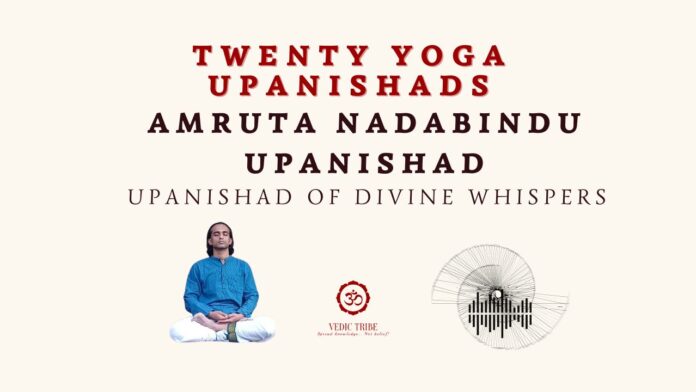What is shadanga yoga?
In the previous article, we discussed Amritabindu Upanishads and in this article, we will discuss – Amruta Nada Bindu Upanishad.
The Amruta Nada Bindu Upanishad delves into the ancient “shadanga-yoga” which is slightly different from Patanjali’s Ashtanga Yoga and also different from the shadanga-yoga of Dhyanabindu Upanishad. “Shadanga” means six limbed whereas “Ashtanga” means eight limbed.
Like other Yoga Upanishads, this Upanishad also discusses Pranava but it also gives a unique knowledge on colour symbols for Prana.
Shadanga Yoga:
The Upanishad contemplates on six-limb yoga; i.e., practice of six steps to reach dissolution of mind.
Pratyahara: Withdrawal of senses and mind inwards
Dhyana: Focusing the mind on breath
Pranayama: Regulation of breath and continued concertation on breath
Dharana: Prolonged concentration
Tarka: Deep contemplation on nature of reality. This is a unique aspect of meditation which is not found in other meditative practices.
Samadhi: Dissolution of mind
Shaivism:
Scriptures: Compilation of this Upanishad coincides with the canonization of scriptures in Shaivism. The Shadanga Yoga of this Upanishad is the same as the Shadanga Yoga in early scripture of Shaivism.
Essential yogic practice: The Yoga-Deeksha in ancient Shaiva tradition required the Samayin (beginners) to have compulsorily practiced Shadanga Yoga before their initiation as “Sadhaka”. In other words, only with the practice of this Shadanga Yoga, Samayin could be promoted as Sadhaka for higher meditative practices.
Difference in Dhyana Bindu Upanishad:
The Shadanga Yoga in Dhyana Bindu Upanishad has a different model: Posture, focus on breath & controlling its pace, withdrawing breath, steadiness of breath, focus of mind and concentration.
Colours of vital force:
Colours: Upanishad indicates different colours for contemplation on different aspect of “Prana” in our body Prana – red as seen in blood; Apana – red as seen in indragopa / mukhmuli insect; Samana – white as seen in milk; Udana – pale white; and Vyana – colour of the bright flame.
Application: The knowledge of application of such colours in meditation practices are now lost and this part of Upanishad only has academic value today.
“Tarka” in meditation:
Tarka: In this Upanishad, it does not mean argument; instead, it means “contemplation”. The Contemplate must be centred upon the knowledge acquired during study of Vedic scriptures (Shastra Jnana).
Contemporary meditation methods: In the contemporary methods, it is suggested to devoid the mind of “thinking or contemplation” during meditation. However, neither Patanjali’s Yoga Sutra nor Yoga Upanishads suggest such a practice. The ancient Yogic tradition always suggests – concentration of mind on an entity and contemplation upon such entity. Such contemplation is a process through which dissolution of mind is achieved.
Dissolution of mind: In traditional yogic practice, the dissolution of the mind—achieved through the complete cessation of mental fluctuations—is a natural outcome of sustained meditation. This natural progression contrasts with modern techniques that demand immediate “non-contemplative” mind, a goal that is often impractical. Understanding and implementing the methodical approach of ancient yogic traditions is essential for successful meditative practice.
Takeaway:
– Study Amruta Nadabindu Upanishad and understand and practice shadanga yoga.
– If you encounter modern meditation technique demanding dissolution of mind from the beginning, question its authority and effectiveness.
In the next article, we will discuss – “Kshurika Upanishad”.
Madhwesh K
Vedic Tribe

